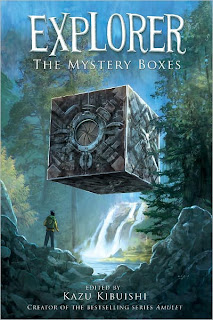There was a spin-off anthology, Flight Explorer, which was specifically targeted to younger (roughly tween) readers -- though with pretty much the same crew of creators, very similar or the same main characters, and not much difference from the main Flight volumes. That was published in 2008, and was billed as "Volume One," though a second volume hasn't yet appeared. (And I reviewed it, as well.)
And now there's Explorer: The Mystery Boxes
Mystery Boxes is the most circumscribed of the books: all of the stories have a mysterious box, which then opens to reveal something wondrous, unpleasant, or otherwise surprising, and then the heroes have to deal with that situation in eighteen pages (or, in one case, only sixteen). The resulting stories are pretty varied, though -- the unpleasant box-dwellers range from the creepy, in Emily Carroll's "Under the Floorboards" to the Warner-Brothers-inspired goofy, in Johane Matte's "Whatzit," and the lesson stories -- like Jason Caffoe's "The Keeper's Treasure," "The Soldier's Daughter" by Stuart Livingston with Stephanie Ramirez, and Kibuishi's own "The Escape Option" -- at least teach slightly different lessons from each other. And the sheer fun-mayhem level is high, in "Whatzit" as well as Dave Roman and Raina Telgemeier's amiable cartoony "Spring Cleaning" and Rad Sechrist's Littles-inspired "The Butter Thief" (which has a muted moral of its own).
As usual, the art is all excellent and very colorful -- even the creators that don't come out of animation embrace mostly bright palettes ("Butter Thief" uses muted tones in pursuit of a similar aim, and "Under the Floorboards" has a softer, scratchier feel) and clean black lines to define spaces. These are fun stories -- with a hint of spinach in the lessons most of them teach -- that should be enjoyed by tweens and viewed favorably by those tweens' gatekeepers (parents, teachers, librarians), who will be happier at those lessons that the target audience probably will be.

No comments:
Post a Comment